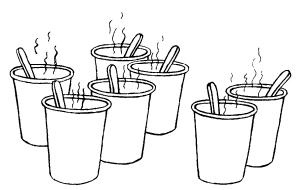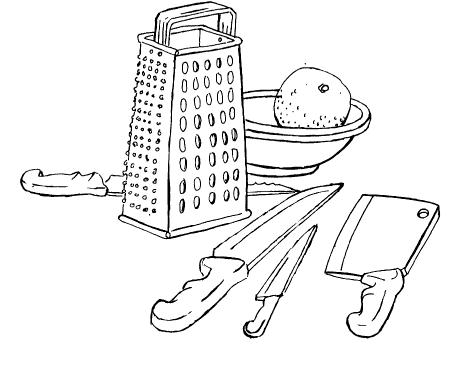
| Contents | Start | Previous | Next |
The same is true for the amount of preparation time each dish requires; the larger the volume, the more efficient each task can be done so that the overall prep time is reduced, In fact, when a particular ingredient is in several dishes on the menu, prep enough of this ingredient for all the dishes at the same time. This can often be done for events taking place over several days, depending on your available storage space and labor.
Again, always strive to be on time for every event where you serve food. Sometimes this is difficult or impossible, but when time is short, you can do the prep work for easy, quick dishes in advance. Do the actual prep and cooking for the longer, more complex dishes at the site itself.
Soup is one dish that lends itself easily to cooking at the event. Upon arrival, set a pot of water to boil, and while that heats, start chopping and adding vegetables. Once the vegetables begin to soften, remove half the soup and serve it. With the remaining half, add more water and vegetables and keep cooking. This can go on indefinitely and become a never-ending pot of soup.
This same concept can be used in a kitchen setting when there is only a short amount of time to cook a large amount of soup or when
the stove is too small for several large soup pots. Follow the normal recipe for vegetable soup, and when the vegetables have been added and the broth just begins to boil, drain off most of the broth and save it in another container. Add more vegetables and a small amount of water to the pot and continue cooking. This pot should now contain enough vegetables and spices for two or more pots of soup but little broth. When the vegetables are cooked, mix them and the broth together again in several containers to transport to the serving site. This method should make two or more pots ofsoup using only one pot and only a little more time.

Try to obtain all the food you use through recovery or donations; however, not all the ingredients for every recipe can be obtained this way. In particular, cooking oils, spices, and dry goods are often difficult to come by. Therefore, some shopping will probably be necessary. Even though it might cost a little more, shop at your local co-op or health food store, buy organically grown food when possible, and avoid packaging as much as possible. Also, bring your own containers.
In the long run, try to shop as little as possible. Identify your regular food needs, and study the food industry for places where waste is created. Go to these places and arrange to recover this food or to have it donated. There is no end to the number of programs you can support with free food if you can successfully learn this process. The vision of Food Not Bombs is abundance, not scarcity.

| Contents | Start | Previous | Next |